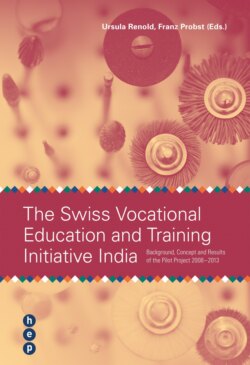Читать книгу The Swiss Vocational Education and Trainig Initiative India - Ursula Renold - Страница 21
На сайте Литреса книга снята с продажи.
4.1 First phase: Curriculum design
ОглавлениеThe first stage in the curriculum value chain is the design of the framework curriculum, which is essential for the entire teaching-learning process. The aim is to train young people for a given occupation. In order to achieve this goal, a conceptual framework for the teaching activities is indispensable. Winch (2010) explains it as follows: «One of the key features of any professional or vocational education worthy of the name is, not merely to enable individuals to attain a threshold level of competence that would allow us to say that they know how to do F, but also to introduce students of a craft, occupation or profession to the standards of excellence that obtain in that activity and to develop in them a desire to attain to those standards. We cannot do that if we do not have available to us the conceptual framework for talking about excellence or, more generally, the difference between a novice and an expert in the particular area of activity with which we are concerned.»
The overall pedagogical and conceptual practices, particularly in VET, should be based on the concept of qualification standards. In Switzerland, all 230 programmes have defined the appropriate VET qualification standards in the form of a framework curriculum. In order to develop these standards, it is useful to involve experts from companies, since only specialists are able to distinguish between a beginner and an expert in a specific field. This is the case in Switzerland, as the professional associations are made up of employers who define the content, professional competences, soft skills and qualification standards in the framework curricula. Therefore, the development of the framework curricula is mainly steered by the professional associations. The state approves and adopts the developed framework curricula and ordinances. Representatives from the cantons, teacher professional groups, sometimes representatives from the unions, SFIVET or other expert organisations also take part in the reform commission, which prepares the foundations for the occupations.
The national framework curricula of the individual VET programmes appertain to the job-specific VET ordinances. In addition to the content-related school workload, the curricula also contain detailed syllabi for the three places of learning. The breakdown of course content between the three places of learning is dependent on the profession. A common schedule for apprentices involves attending vocational school one day a week, and working four days a week in the company offering the training. Alternatively, two days a week are spent at the vocational school and three days at the company. Industry courses are usually offered as block courses. Likewise, there is a widespread regressive school model, in which attendance at vocational school is more frequent in the first year, and becomes progressively less frequent each subsequent year. This helps to improve the apprentices’ productivity in the company over the years. A further variant, which is more prevalent in the French and Italian-speaking parts of Switzerland, is to attend vocational school for a few weeks and then apply the newly-acquired knowledge in industry training centres for a few weeks. The different variants in the places of learning illustrate that it is not the way in which VET is completed that is crucial but rather whether the acquired qualifications meet the required standards. The length of the programmes varies between two and four years. The Federal VET Certificate lasts two years and is intended more for students with weaker academic performance but better practical ability. To obtain a Federal VET Diploma, a three to four-year apprenticeship has to be completed, the exact duration of which depends on the VET programme and the cost-benefit ratio of the companies providing the training.
In summary, one can say that the framework curricula developed in the first phase cover the qualification standards for all places of learning, as well as define the professional, social, methodical and personal skills required (also called capacity-building).
